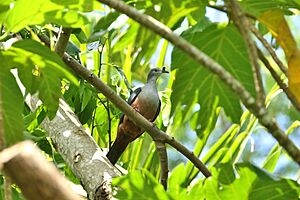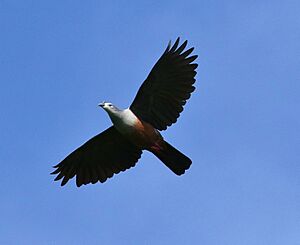Micronesian imperial pigeon facts for kids
The Micronesian imperial pigeon (also called the Micronesian pigeon or Belochel) is a type of bird that belongs to the dove family. You can find this pigeon on islands like Palau, the Caroline Islands, the Marshall Islands, and Nauru. It lives in different kinds of forests, including mountain forests, beach forests, and mangrove swamps. This pigeon is facing threats like hunting and losing its home due to trees being cut down. Because of this, experts say it's a vulnerable species, meaning it needs protection.
Quick facts for kids Micronesian imperial pigeon |
|
|---|---|
 |
|
| Conservation status | |
| Scientific classification | |
| Genus: |
Ducula
|
| Species: |
oceanica
|
| Synonyms | |
|
Columba oceanica Desmarest, 1826 |
|
Contents
About the Micronesian Imperial Pigeon
This bird was first officially described in 1826. Scientists gave it the name Columba oceanica back then. Today, we know it as Ducula oceanica.
There are five different types, or subspecies, of the Micronesian imperial pigeon:
- D. o. monacha: found in Palau and Yap.
- D. o. teraokai: lives on Chuuk.
- D. o. townsendi: found on Pohnpei.
- D. o. oceanica: lives on Kosrae.
- D. o. ratakensis: found in the Marshall Islands.
What Does This Pigeon Look Like?
The Micronesian imperial pigeon is about 36 centimeters (14 inches) long. It usually weighs between 340 and 406 grams (12 to 14 ounces).
Here are some of its features:
- Its head and neck are a light grey color.
- Its back and the top parts of its wings are dark green, which can look dark blue in some light.
- The flight feathers (the long feathers used for flying) are blackish with a green shine.
- Its chest is light grey, and the area under its tail is a dark reddish-brown.
- The tail is blackish on top and dark brown underneath.
- It has a black beak and black skin around its nostrils (called a cere).
- Its eyes are reddish-brown, and its feet are purplish-red.
Female pigeons and younger birds tend to be a bit darker in color. The different subspecies can be told apart by their size and the color of their heads. This bird can make many different sounds, like barks, coos, and moans. It is also likely a strong flyer.
Where Does This Pigeon Live?
The Micronesian imperial pigeon lives on several islands in Micronesia. These include the Marshall Islands, Yap, Chuuk, Pohnpei, and Kosrae. You can also find it on Nauru and Kiribati, and in Palau. Sadly, the populations on many of the Marshall Islands might have disappeared.
On islands like Pohnpei and Kosrae, these pigeons mostly live in the mountains. In places where they are not hunted, they can be found in different types of forests. This includes forests that are growing back, forests along beaches, and mangrove swamps. They also live in coconut tree farms. Scientists have found old bones of this pigeon in the Mariana Islands, showing they once lived there too.
How Does This Pigeon Behave?
This pigeon usually lives alone and is often seen high up in the trees. It mostly eats fruits and seeds that have a soft, fleshy part.
Its calls are quite interesting:
- A deep, throaty bark that sounds like grrow-row-row-ow.
- A soft moan.
- Mellow cooing sounds.
Not much is known about how these pigeons raise their young. However, it is thought that they might be able to breed throughout the entire year.
Protecting the Micronesian Imperial Pigeon
Surveys have shown that the number of Micronesian imperial pigeons has gone down in some areas. For example, a 2005 survey in Palau found fewer birds, though they were still common in some places. On Nauru, a survey in 2006-2007 estimated there were only about 75 to 100 birds left.
The main reasons why the Micronesian imperial pigeon population is shrinking are:
- Hunting: People hunt these pigeons, which has likely caused their numbers to drop in places like Palau and Nauru.
- Deforestation: Their homes are being destroyed when trees are cut down.
Because of these threats, the population of the Micronesian imperial pigeon is likely getting smaller. The International Union for Conservation of Nature (IUCN) has listed this species as Vulnerable. This means it is at a high risk of becoming extinct if we don't protect it.



